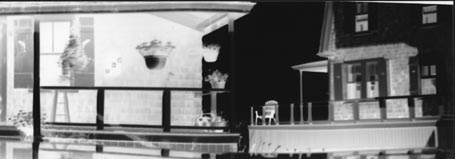
Entries from August 1, 2008 - August 31, 2008
Design snapshot: Procession pointers
 Here, what might otherwise have been a utilitarian connection between driveway and lawn is instead a celebrated passage. Landscape elements team with a clear-finished arbor to create a gateway between an upper-level driveway and a lower-level lawn. Bluestone treads carved into dry-laid, stone planters elegantly invite yard access. The narrow arbor overhead announces the yard entrance for those approaching from the driveway. Climbing vines integrate the arbor architecture with the garden below.
Here, what might otherwise have been a utilitarian connection between driveway and lawn is instead a celebrated passage. Landscape elements team with a clear-finished arbor to create a gateway between an upper-level driveway and a lower-level lawn. Bluestone treads carved into dry-laid, stone planters elegantly invite yard access. The narrow arbor overhead announces the yard entrance for those approaching from the driveway. Climbing vines integrate the arbor architecture with the garden below.
When designing the procession from car to house, or car to garden, allow for imaginative gateways along the path to enhance the journey.
by Katie Hutchison for the House Enthusiast
Fall 2008 continuing education
Recommended New England course about alternative photography
 Pinhole photo I took with a Goya cracker tin in Marian Roth's workshop via the PAAM
Pinhole photo I took with a Goya cracker tin in Marian Roth's workshop via the PAAM
Lately, I’ve developed a taste for back-to-basics photography. I’ve been experimenting with a toy camera and pinhole photography. I had hoped to find a bunch or New England workshops on the topic to suggest for the fall. Thus far I’ve only found one, which I’ve listed below. It looks intriguing. You might consider perusing The Book of Alternative Photographic Processes by Christopher James too.
New England School of Photography
I’ve taken and enjoyed many workshops here. Whether you’re a budding photographer or a practicing professional, there’s something for everyone at NESOP.
(Class and schedule are subject to change so check program website for updates.)
Instructor: Ron Cowie
Mondays, Sept. 15-Dec. 8, 6:00-9:00pm
$365 before Sept. 12/$400 after Sept. 12
“This class studies and practices 19th century photo processes. We will explore salt printing, cyanotype, platinum printing, pinhole photography and more. These processes require a deeper level of connection with materials and are a jumping-off point to a world of greater creativity. Class time will be divided into demonstration, lecture, class critique and guest speakers. In short, this class hopes to create a safe space where you can take a chance, play and fall back in love with photography. Students are expected to bring negatives and purchase their own materials for each process they wish to explore beyond the demonstration.”
by Katie Hutchison for the House Enthusiast
Web tour: Boston Sunday Globe: First impressions
 Yin Yu Tang at the Peabody Essex Museum, a destination cited by Smee
Yin Yu Tang at the Peabody Essex Museum, a destination cited by Smee
It’s Tuesday, and as usual I’m still sampling the Sunday paper. Over breakfast I read Sebastian Smee’s “In praise of first impressions” about the rewards of an open mind when viewing art. He suggests we approach art as a discovery, in much the same spirit as the art was produced. Smee writes, “It’s easy to forget…that artists – at least the best ones – create things not because they know stuff and want to tell us about it, but precisely because they don’t know stuff, and want to explore that state of not knowing, to feel it out, to prod it, isolate it, and reconnect it with other kinds of experience.” Touché.
by Katie Hutchison for the House Enthusiast
Web tour: Boston Sunday Globe: 1% pro bono
The Globe touts the 1% pro bono campaign conceived by Public Architecture, a nonprofit design firm founded by John Peterson in San Francisco. The campaign has created a network of architects and designers who commit one percent of their hours to pro bono projects. According to the Globe story, Brandy Brooks the executive director of Community Design Resource Center of Boston, a non-profit partner with Public Architecture, said “I think there’s a lot of confusion about what architects do… People don’t recognize that they have a right to well-designed buildings and spaces. That this isn’t just an artistic service. It’s essential.” A worthy attitude for a worthy cause.
by Katie Hutchison for the House Enthusiast
Design snapshot: Driveway do's
 Nestled against an enormous rock outcropping, this brick driveway seems to grow organically from its site. The low, canted, boulder wall snakes along the edge of the outcropping and perimeter plantings to delineate two edges of the driveway. Three rows of Belgian block, laid flush with grade in lieu of a more containing wall, comprise the third, thick edge. Within the stone borders, old bricks intermingle with moss to provide a loosely defined car pad that could just as easily function as a modest, pocket patio. For versatile, appealing results, think of the driveway as part of the garden design.
Nestled against an enormous rock outcropping, this brick driveway seems to grow organically from its site. The low, canted, boulder wall snakes along the edge of the outcropping and perimeter plantings to delineate two edges of the driveway. Three rows of Belgian block, laid flush with grade in lieu of a more containing wall, comprise the third, thick edge. Within the stone borders, old bricks intermingle with moss to provide a loosely defined car pad that could just as easily function as a modest, pocket patio. For versatile, appealing results, think of the driveway as part of the garden design.
by Katie Hutchison for the House Enthusiast















